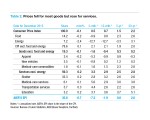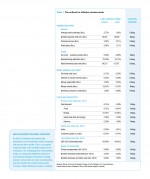Inflation
Scorecard
With oil prices continuing to fall and the dollar still strengthening in December, the month-to-month outlook for inflation remains weak. Out of 23 indicators tracked in the AIER Inflationary Pressures Scorecard, 14 show falling pressure, one is stable, and eight indicators support rising pressure.
Special attention should be given to the money and credit landscape this month. The impact on inflation of the Federal Reserve’s tighter monetary policy has kicked in. Since the Fed in December raised interest rates, money supply growth has slowed, putting downward pressure on inflation.
Consumer demand slackened in recent months. That was reflected in declining December retail sales and slower growth in personal income, pointing to falling inflationary pressure. In response to diminished demand, supply fell, as measured by industrial production. But falling supply supports higher consumer prices in the future. In other words, the effect of the weaker demand was offset by the decreased supply, together suggesting a neutral impact on inflation.
Cheap oil and a strong dollar continue to depress prices of food, energy, and imports. There is no sign of runaway inflation in the near term.
Consumer Price Index Analysis
The Consumer Price Index, or CPI, slipped 0.1 percent in December from November, mainly from a sharp decline in energy costs. Energy fell 2.4 percent, and households also paid less for food. Food prices in December declined 0.2 percent from November and were 0.9 percent lower than three months earlier.
Food and energy prices are usually considered volatile. The core CPI excludes both and is seen as a better measure for a long-term perspective. The core CPI rose 0.1 percent in December from November. For the year, the core CPI advanced 2.1 percent, or close to the Fed’s annual inflation target of 2 percent, which may help Fed officials breathe a little more easily.
Most goods in the CPI basket were cheaper in December, including apparel, alcoholic beverages, and new vehicles. However, prices rose for household furnishings and educational books and supplies. All services, without exception, were more expensive.
The month-to-month price divergence between goods and services was in line with the long-term trend. Goods (excluding food and energy) grew at an annual 0.2 percent rate over the past 20 years, while services (excluding energy) advanced at a 2.8 percent rate. Households have consistently seen faster cost increases for services than goods in the past two decades.
Among all services, the fastest growth has come in education, up by an annualized rate of 3.7 percent over the past five years and 5.1 percent over the past two decades. It was followed by medical-care services, which rose 3 percent annually over the past five years and by about 3.8 percent in each of the past 20 years.
Ignoring food and energy prices, core CPI inflation has been fairly stable not only in the recent past but also over the long run. It has grown at a consistent rate of about 2 percent annually. Going forward, if energy prices stop falling or decline more slowly, CPI inflation is likely to grow.
Click here to receive email notifications when the latest Business Conditions Monthly is available.
Everyday Price Index
AIER’s Everyday Price Index, a measure of inflation for commonly purchased goods and services, declined 0.7 percent in December after falling 0.6 percent in November. For the full year, the EPI sank 1.9 percent.
The broader Consumer Price Index slipped 0.1 percent in December and rose 0.7 percent for the year. Because the EPI assigns a greater weight to energy, the difference between the two stems largely from lower costs for fuels and power.
Energy prices fell 2.4 percent in December and slid 12.7 percent for the year because of abundant supplies. Gasoline prices dropped 3.9 percent in December, capping a 19.7 percent plunge over 12 months. Even with winter in full swing, home heating oil fell 4 percent.
The 0.5 percent decline in food prices at grocery stores in December was broad based. Meat, poultry, fish, and egg prices dropped 1.4 percent; fresh produce fell 0.5 percent; and bakery products declined 0.1 percent. Restaurant food prices, on the other hand, increased 0.1 percent and climbed 2.6 percent for the year.
Prescription drug prices fell 0.3 percent in December, and the cost of personal-care services declined 0.2 percent. However, both prescription drug and personal-care services costs rose 2.4 percent in 2015.


